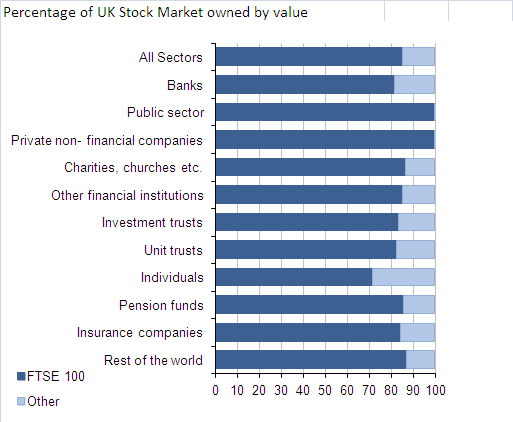Institutional Ownership Definition Example
Post on: 31 Май, 2015 No Comment

What it is:
Institutional ownership refers to the ownership stake in a company that is held by large financial organizations, pension funds or endowments. Institutions generally purchase large blocks of a company’s outstanding shares and can exert considerable influence upon its management.
How it works/Example:
Although many companies — particularly large, blue-chip firms — have thousands of individual stockholders, a select few of those owners will often hold the majority of the shares. These large institutional traders are typically well funded and routinely accumulate millions of shares of a single stock. Examples of institutional owners include corporate pension funds. college endowments, insurance companies, commercial banks, hedge funds, mutual funds. and boutique asset management firms that invest money for wealthy clients. On any given day, institutions usually account for the vast majority of the trading volume on major exchanges such as the NYSE and Nasdaq .
When it comes to common stocks. institutional ownership is often expressed as a percentage of a firm’s outstanding shares. This figure represents the percentage of a company’s shares that are held by institutions. This information can usually be found along with a list of a firm’s largest shareholders at Yahoo Finance, Investors Business Daily and other online financial sources. In addition, any owner who establishes a position exceeding 5% of the outstanding shares of any stock must disclose the details within ten days by filing a Form 13-D with the SEC.
Why it Matters:
Given the considerable sums of money that institutions invest, it is not surprising that they tend to be much more knowledgeable than the average investor when it comes to the companies and industries in which they have invested. Institutional portfolio managers often meet personally with a company’s top executives, and in many cases the research they conduct is further supported by equity analysts — known as buy side analysts — who evaluate prospective companies and industries in great depth before making specific investment recommendations.
It is important to note that institutional ownership is not governed solely by a particular security’s fundamental prospects. Internal policies or objectives, SEC regulations, time horizon, and a variety of other factors can have a major impact on a particular institution’s investment decisions and thus its ownership positions. For example, some institutions may be restricted from investing in certain companies or industries, and others may make decisions based on future cash needs (as is often the case with pension funds ).

Considering the vast amount of resources, talent, and research capacity these large money managers have at their disposal, their investing decisions tend to carry a great deal weight with smaller investors, many of whom scrutinize institutional trading patterns carefully. For this reason, institutional trading can have an enormous impact on the price of individual securities and can even influence the direction of the broader markets.
Many investors regard institutional support for a security as a sign of approval, and institutional accumulation of a stock can raise its price considerably. However, other investors believe that once many institutions have piled into a company’s shares. it is too late to realize substantial gains. These investors deliberately seek investments with little or no institutional ownership under the assumption that bigger traders will soon discover the security and push its price higher.
Just as rising institutional ownership can lift a security’s price, decreasing ownership can sometimes trigger a collapse in the shares. Aside from the adverse impact of the large sell orders themselves, the actions are often taken as a lack of confidence in the company, which may motivate other investors to sell the shares as well. Thus, institutional buying and selling — particularly so-called program trading — can inject a large amount of volatility into a stock. Therefore, institutions are seldom able to purchase thinly-traded, small-cap stocks. and large positions must often be sold off in pieces.
Finally, institutions wield tremendous influence in other matters as well. Since these major organizations are often a company’s largest shareholders, they are not shy about offering suggestions or opinions from time to time — often publicly. For example, institutional owners may sometimes pressure management into restructuring the company, divesting certain business segments, selling off assets, or even putting the firm itself up for sale. Occasionally, they may even express their disapproval by launching a proxy battle.














